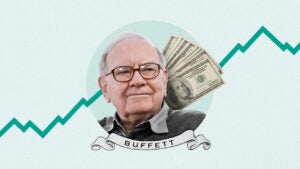How to invest in a ‘higher for longer’ interest rate environment

Entering 2024, investors seemed focused on the question of how many times the Federal Reserve would cut interest rates. But with inflation remaining stubbornly high and above the Fed’s long-term target of two percent, more analysts are starting to question if we’ll see rate cuts at all this year.
Market participants seem to be warming to the idea that interest rates will have to stay “higher for longer” as long as the economy remains strong and the Fed works to bring inflation down to its target. Here’s how to position your portfolio in an environment where rates stay elevated.
Where to invest if interest rates stay high
1. Value stocks
Value stocks may do well in a higher interest rate environment as investors look for companies with strong cash flows and expect to see immediate profitability in their underlying holdings. Value stocks tend to trade at low multiples of earnings and cash flow, which means it will take less time to earn back your investment if a company can maintain the same level of profitability.
When interest rates were at record lows, investors bid up the shares of high growth companies even though many were reporting significant losses with the hope that profitability would come at some point in the future. But higher interest rates have changed the equation and investors want to see a greater focus on profitability as borrowing costs have risen and the returns from holding cash have become more attractive.
2. Dividend stocks
Dividend stocks should also do well in an environment where interest rates stay high because the dividend payments offer an immediate return to investors. After you receive the dividend, you can decide whether to reinvest the proceeds back into the company or find a better use for the cash.
You can invest in individual stocks that pay dividends or find a fund that holds dividend paying stocks. A fund is a great way to reduce your risk through diversification, which means you won’t get hurt if some companies have to cut their dividend or see their businesses suffer.
3. Money market funds
Money market funds are one of the safest investments you can make and they’re offering attractive yields for the first time in quite a while. Money market funds invest in high quality short-term securities to provide current income while maintaining stability and high levels of liquidity.
As of May 2024, investors can earn 5 percent or more in money market funds, a decent return for taking very little risk. These yields are very sensitive to changes in Fed policy, however, so if rates do come down, the yields on money market funds will also fall. But investors will continue to earn attractive returns as long as rates stay high.
4. Bonds
Bonds also offer decent yields for the first time in several years. Investors can lock in yields of around 5 percent and could see even greater gains if interest rates fall from current levels. Bond prices and yields move in opposite directions, so when rates fall, bond prices rise.
Bond prices were hammered in 2022 as the Fed started hiking interest rates, but yields are now more attractive. Investors may want to consider extending the duration of their bond holdings to lock in higher interest rates now in case rates do head lower.
5. Financial stocks
Financial stocks are another area to consider if rates stay higher for longer because companies such as banks and insurers benefit from higher interest rates. Banks are able to earn more on loans while insurance companies earn more on their fixed income investments. Insurers have also been able to raise premiums substantially as they deal with the impact of higher inflation.
Financial companies struggled in the ultra low-rate environment because of the low spread on lending and low returns available in fixed-income assets. That situation has changed and should benefit financial stocks as long as rates stay elevated.
Editorial Disclaimer: All investors are advised to conduct their own independent research into investment strategies before making an investment decision. In addition, investors are advised that past investment product performance is no guarantee of future price appreciation.
Why we ask for feedback Your feedback helps us improve our content and services. It takes less than a minute to complete.
Your responses are anonymous and will only be used for improving our website.
You may also like


Best long-term ETFs to buy and hold

Best ETFs for rising interest rates



